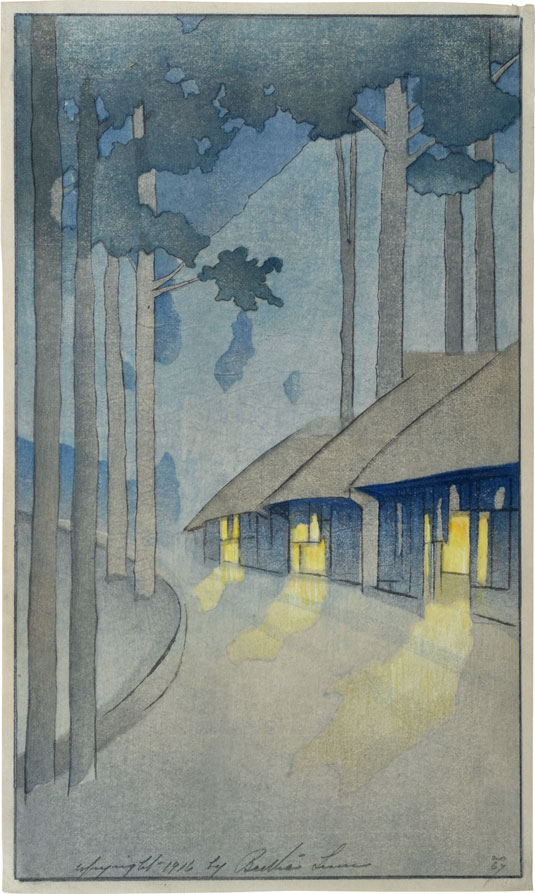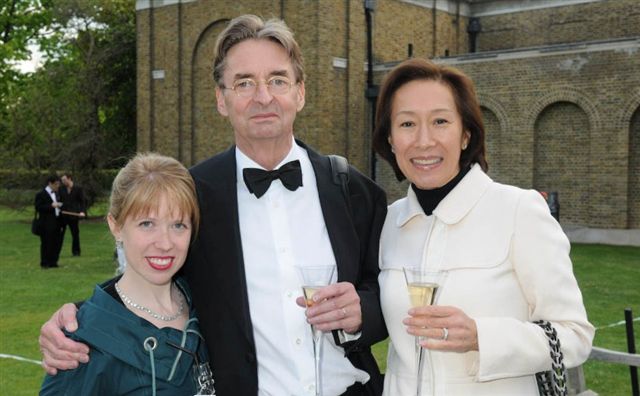
Bertha Lum (1869-1954), Road to the Forest at Nikko, woodblock print, 13 x 7 3/4 in.
Scholten Japanese Art, which opened in New York in 2000 and has presented more than fifty exhibitions of fine Japanese prints, paintings, and works of art, has never hesitated to explore new artistic avenues to bring the best and most interesting artworks to their collectors and visitors. In the past several years, Rene Scholten and Katherine Martin, President and Director of the gallery, respectively, have expanded the parameters of what is considered Japanese prints and paintings. Namely, their exhibitions have included art by non-Japanese artists influenced by the techniques and imagery that characterizes Japanese traditional visual culture, as well as the impact of Western influences on Japanese artists. The former theme has been at the heart of Scholten’s most recent and upcoming exhibitions.
The gallery described their spring exhibition, Influencers: Japonisme and Modern Japan as “an exploration of the influence of Japanese art on Western art and the development of modern international art modes such as art nouveau and art deco.” Included were 102 woodblock prints and paintings by important artists—male and female—from France, Austria, Germany, Britain, and the United States, as well as from Japan. (Read and see more about this exhibition, click here.) Katherine Martin, who has directed the gallery since 1999, after several years as specialist of Japanese art at Sotheby’s, commented that she has long been fascinated by exchanges between artists of different cultures, and that even though artistic interactions between Japan and the West are well explored, new ones are always a “revelation.” Martin pointed to a particularly striking example. . . the clear similarity between a print by Utagawa Hiroshige and a painting by James Whistler, who was greatly influenced by the Japanese master, although he never traveled to the country. Especially interesting is that early modern Japanese printmakers were in turn much taken with impressionist artists such as Whistler, as can be seen in a print made by Kobayashi Eijiro.
L-R: Utagawa Hiroshige (1797-1858), Full Moon Over Canal, with Bridge and Huge Stacks of Bamboo along the Bank, woodblock print, circa 1857, Scholten Japanese Art; James Whistler (1834-1903), Nocturne: Blue and Gold-Old Battersea Bridge, circa 1972-5, oil on canvas, Tate Britain (NO1959); Kobayashi Eijiro (1870-1946), Night Scenes: High Bridge by Night, ca. 1910-20s, Scholten Japanese Art
The Influencers exhibition emphasized an exploration of works by non-Japanese artists who employed the woodblock print-making process. Not only were these artists often self-taught, figuring out on their own how their Japanese predecessors achieved various visual effects, but they were often obliged to undertake all aspects of the printmaking process themselves, as they did not have available to them the numerous craftsmen with whom Japanese artists could collaborate. The works of these artists, such as Emil Orlik, B.J.O. Nordfeldt, John Edgar Platt, and Bertha Lum, in turn played a role in reviving interest in woodblock printmaking in Japan, known as the shin-hanga (“new prints”) movement of the early 20th century.
Martin observed that exhibitions at Scholten are a collaboration between herself and Rene Scholten and often “percolate” for years, as additions to the roster are acquired and new artists discovered. Martin was surprised and pleased with the very positive response to Influencers, both by experienced print collectors and several new enthusiasts and that works by the non-Japanese artists sold very quickly.

L-R: Katherine Martin, Rene and Margriet Scholten, 2010
Scholten’s upcoming exhibition, NOH: More Drama, which opens on June 16th, presents paintings, drawings and prints of Japanese theatrical subjects by Paul Binnie. (For more information about this exhibition, click here and watch these pages.) This is the gallery’s fourth solo exhibition of work by this artist, who was born in Scotland in 1967 and spent several years in Japan as an apprentice to learn traditional woodblock printing techniques. Binnie’s use of both Japanese and Western artistic practices to produce images that draw on imagery from many sources is the ongoing embodiment of Scholten gallery’s keen interest in following unexpected developments within the traditions of Japanese art and woodblock printmaking.
